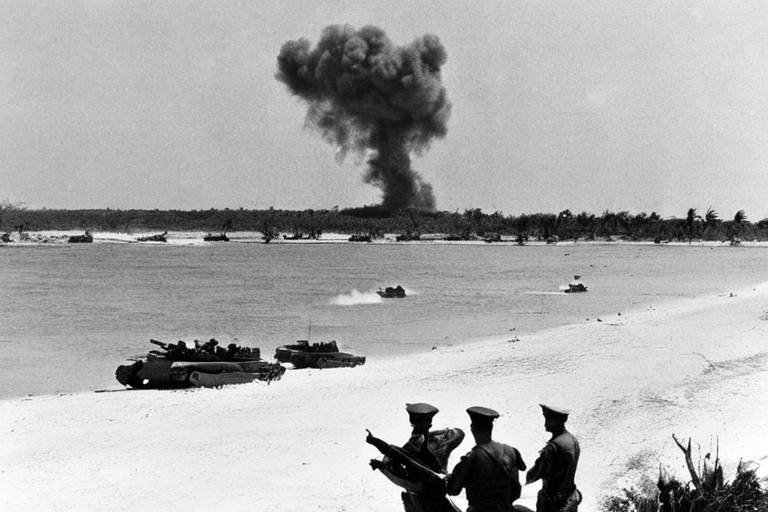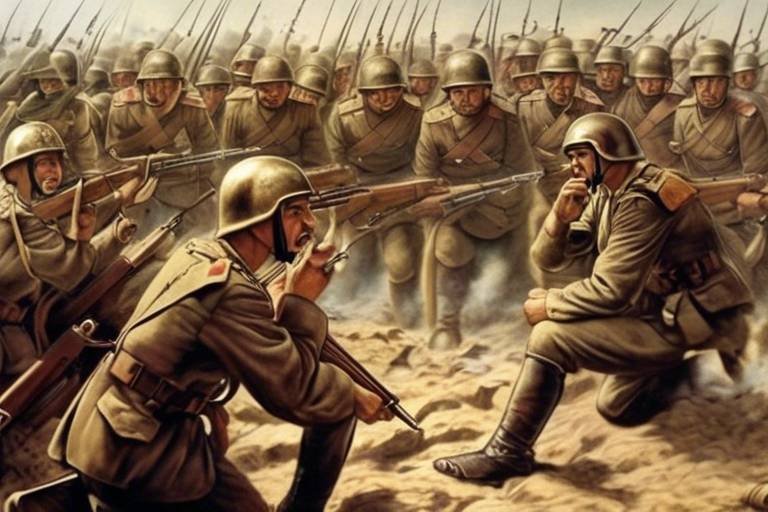The Historical Context of the Mexican-American War
The Mexican-American War, a significant conflict that left a lasting impact on the borders and histories of both the United States and Mexico, was not simply a sudden eruption of violence. To truly grasp the causes and consequences of this war, one must delve into its historical context, which is a complex tapestry woven from territorial disputes, political ambitions, and ideological clashes.
As tensions simmered between the United States and Mexico, the annexation of Texas in 1845 served as a spark that ignited the powder keg of conflict. The concept of manifest destiny, the belief that American expansion was not only inevitable but divinely ordained, further fueled the flames of war. The Mexican government's refusal to recognize the independence of Texas and the border dispute over the Rio Grande added fuel to the fire, eventually leading to the outbreak of hostilities in 1846.
Key figures such as President James K. Polk of the United States and General Antonio López de Santa Anna of Mexico emerged as central players in this unfolding drama. Their decisions and actions would shape the strategies and outcomes of the war, influencing the course of history for both nations.
For Mexican society, the aftermath of the war was devastating. The loss of vast territories, including present-day California, Nevada, and Utah, dealt a severe blow to Mexico's economy and political stability. The repercussions of this conflict would echo through Mexican history for generations to come, shaping national identity and foreign relations.
The military campaigns and battles of the Mexican-American War, from the clash at Palo Alto to the decisive Siege of Veracruz, showcased the military prowess and tactics of both sides. These engagements highlighted the brutal realities of war and the sacrifices made by soldiers on both sides of the conflict.
With the signing of the Treaty of Guadalupe Hidalgo in 1848, the war officially came to an end. This treaty not only established the Rio Grande as the border between Texas and Mexico but also ceded vast swathes of territory to the United States, forever altering the geopolitical landscape of North America.
The legacy of the Mexican-American War endures to this day, shaping the cultural identities and historical narratives of both nations. The scars of this conflict continue to influence relations between the United States and Mexico, underscoring the complexities of shared history and divergent perspectives.
As scholars and historians continue to dissect the events of the Mexican-American War, diverse perspectives emerge regarding themes of imperialism, nationalism, and identity. This pivotal moment in North American history invites reflection and analysis, challenging us to confront the complexities of the past and their enduring impact on the present.

Causes of the Mexican-American War
The causes of the Mexican-American War can be traced back to a complex web of factors that culminated in a significant conflict between the United States and Mexico. One of the primary catalysts was the annexation of Texas by the United States in 1845, which Mexico vehemently opposed, as it considered Texas part of its territory. This annexation dispute exacerbated existing tensions between the two nations and set the stage for further hostilities.
Moreover, territorial disputes over the boundaries of Texas further fueled the flames of conflict. The United States claimed the border of Texas extended to the Rio Grande, while Mexico asserted that the Nueces River was the rightful boundary. This disagreement over territory became a flashpoint for military confrontations and escalated the simmering tensions between the two countries.
Another key factor contributing to the outbreak of the Mexican-American War was the concept of manifest destiny, a belief prevalent in the United States that it was destined to expand its territory across the North American continent. This ideology fueled American expansionism and justified the acquisition of Mexican lands, leading to a clash of interests and ideologies between the two nations.
Additionally, the divergent political systems and ideologies of the United States and Mexico played a significant role in exacerbating the conflict. The United States, with its democratic government and capitalist economy, clashed with Mexico's authoritarian regime and agrarian society. These ideological differences further strained diplomatic relations and set the stage for armed conflict.

Key Players in the Conflict
When delving into the historical narrative of the Mexican-American War, it becomes evident that key players on both sides significantly influenced the course of the conflict. President James K. Polk of the United States emerged as a central figure whose expansionist policies and aggressive stance towards Mexico set the stage for the war. Known for his fervent support of manifest destiny, President Polk sought to acquire new territories for the United States, including those held by Mexico.
On the Mexican side, General Antonio López de Santa Anna played a pivotal role in shaping the military strategies and responses to the American incursions. As a seasoned military leader and former president of Mexico, Santa Anna's leadership during the war was marked by both victories and defeats, reflecting the complex dynamics of the conflict.
President Polk's unwavering determination to acquire Mexican territories clashed with Santa Anna's efforts to defend his country's sovereignty, leading to a series of confrontations that would ultimately define the outcome of the war. The clash of ideologies and ambitions between these two key players underscored the deep-seated tensions that fueled the Mexican-American War.
While President Polk and General Santa Anna stood at the forefront of the conflict, it is essential to recognize the countless soldiers, commanders, and civilians whose actions and sacrifices also shaped the course of the war. Their stories, often overshadowed by the prominence of political leaders, offer a nuanced perspective on the human toll and complexities of armed conflict.
As we reflect on the key players in the Mexican-American War, it becomes clear that the decisions and actions of individuals, whether in positions of power or on the front lines, reverberated far beyond the battlefield, leaving a lasting impact on the histories of both nations involved.

Impact on Mexican Society
The Mexican-American War had a profound impact on Mexican society, leaving a lasting mark on the country's social, economic, and political landscape. The conflict resulted in significant territorial losses for Mexico, with the signing of the Treaty of Guadalupe Hidalgo in 1848 ceding vast territories to the United States. This loss of land, including present-day California, Texas, and parts of several other states, had a devastating effect on Mexico's economy and resources.
Furthermore, the war exacerbated existing socio-economic inequalities within Mexican society. The economic devastation caused by the conflict led to widespread poverty and hardship for many Mexicans, particularly those living in the newly acquired territories now under American control. The displacement of populations and disruption of traditional ways of life further contributed to social upheaval and instability.
In addition to the economic and social consequences, the Mexican-American War also had a profound impact on Mexico's political landscape. The defeat in the war and the subsequent loss of territory fueled political unrest and instability within the country. The government faced challenges in maintaining control and legitimacy, leading to a series of political upheavals and power struggles in the years following the war.
Moreover, the war deepened the sense of national identity and pride among Mexicans, as the conflict highlighted the country's struggle against foreign aggression and intervention. The experience of the war shaped Mexican perceptions of the United States and influenced diplomatic relations between the two countries for decades to come.

Role of Manifest Destiny
The in the Mexican-American War cannot be understated. Manifest Destiny was a widely held belief in the United States during the 19th century that its settlers were destined to expand across North America. This ideology fueled the push for westward expansion, driving the annexation of Texas and escalating tensions with Mexico.
Manifest Destiny served as a justification for American territorial ambitions, framing the conflict with Mexico as a natural extension of the nation's destiny to spread democracy and civilization. It provided a sense of moral righteousness and divine mission to the expansionist policies pursued by the United States government.
Under the banner of Manifest Destiny, the United States sought to fulfill its perceived duty to bring progress and development to the western frontier, often at the expense of indigenous peoples and neighboring nations. The belief in Manifest Destiny not only influenced government actions but also shaped public opinion, garnering popular support for territorial acquisitions and military interventions.
As the Mexican-American War unfolded, Manifest Destiny provided a powerful ideological backdrop, justifying the conflict as a necessary step in fulfilling the nation's manifest destiny of continental expansion. The rhetoric of manifest destiny was used to rally support for the war effort and frame the territorial ambitions of the United States as a noble pursuit of a higher purpose.
In hindsight, the role of Manifest Destiny in the Mexican-American War raises complex questions about the intersection of ideology, power, and national identity. It prompts us to reflect on the consequences of imperial ambitions and the narratives that shape historical events, inviting us to critically examine the legacy of Manifest Destiny in the broader context of American history.

Battles and Military Campaigns
The Mexican-American War was marked by a series of intense battles and military campaigns that shaped the outcome of the conflict. One of the first major engagements was the Battle of Palo Alto on May 8, 1846, where American forces clashed with Mexican troops in a decisive confrontation. This battle set the stage for further military actions and demonstrated the determination and strategies of both sides.
As the war progressed, the Siege of Veracruz emerged as a significant military campaign that highlighted the American military's siege tactics and the resilience of the Mexican defenders. The siege, which lasted from March 9 to March 29, 1847, resulted in the surrender of the city and paved the way for the advance of American forces into Mexican territory.
Another notable battle was the Battle of Chapultepec on September 13, 1847, where American troops launched a fierce assault on the Mexican stronghold of Chapultepec Castle. The battle, which culminated in the capture of the castle, symbolized the turning point in the war and the eventual defeat of Mexican forces.
Throughout the Mexican-American War, military campaigns such as these showcased the bravery and tactics of soldiers on both sides, as well as the strategic decisions made by military leaders. These battles not only determined the outcome of the conflict but also left a lasting impact on the historical narrative of the war and the subsequent relations between the United States and Mexico.

Treaty of Guadalupe Hidalgo
The Treaty of Guadalupe Hidalgo, signed on February 2, 1848, marked the official end of the Mexican-American War. This pivotal agreement between the United States and Mexico not only brought an end to the hostilities but also established the terms that would shape the future of both nations.
One of the key provisions of the treaty was the recognition of the Rio Grande as the southern border of Texas, solidifying the territory's annexation by the United States. Additionally, Mexico ceded vast swathes of land to the United States, including present-day California, Arizona, New Mexico, Nevada, Utah, and parts of Colorado and Wyoming.
The Treaty of Guadalupe Hidalgo also addressed the issue of compensation for the Mexican government, with the United States agreeing to pay $15 million to Mexico in exchange for the territories acquired. This financial aspect of the treaty was significant in shaping the economic repercussions of the war for both countries.
Furthermore, the treaty included provisions to protect the rights and property of Mexican citizens living in the newly acquired territories, ensuring a degree of stability and continuity for those affected by the change in sovereignty.
Overall, the Treaty of Guadalupe Hidalgo not only marked the end of a military conflict but also set the stage for a new chapter in the history of both the United States and Mexico. Its impact on the geopolitical landscape of North America and the cultural heritage of the region continues to be felt to this day.

Legacy of the Mexican-American War
The legacy of the Mexican-American War is deeply intertwined with the historical narratives and cultural identities of both the United States and Mexico. The repercussions of this conflict continue to shape the relations between the two nations and have left a lasting impact on the territories involved.
One of the most significant legacies of the Mexican-American War is the vast territorial changes that occurred as a result of the conflict. The Treaty of Guadalupe Hidalgo, signed in 1848, ceded territories such as California, Arizona, New Mexico, and parts of Colorado, Nevada, and Utah to the United States. This reshaping of borders has had lasting consequences on the demographics, economies, and political landscapes of both countries.
Furthermore, the war left a mark on the social fabric of Mexican society, leading to a sense of loss and resentment that continues to be felt to this day. The economic devastation and political instability that followed the war created deep-seated challenges for Mexico, contributing to a legacy of inequality and struggle that persists in various forms.
From a broader perspective, the Mexican-American War also influenced the trajectory of American expansionism and foreign policy. The acquisition of vast territories through the conflict fueled debates over the morality and implications of territorial expansion, shaping subsequent discussions on imperialism and national identity in the United States.
Moreover, the legacy of the Mexican-American War serves as a reminder of the complexities and consequences of armed conflict, highlighting the far-reaching impacts that wars can have on societies, cultures, and geopolitical dynamics. By examining the legacy of this pivotal moment in history, we gain insights into the interconnected histories of the United States and Mexico, shedding light on the enduring significance of the war in shaping the present-day relationships between the two nations.

Historical Perspectives and Interpretations
Scholars and historians offer a myriad of perspectives on the Mexican-American War, delving into the complexities of imperialism, nationalism, and identity within the historical context of this pivotal moment in North American history. Some interpretations focus on the expansionist ambitions of the United States driven by the doctrine of manifest destiny, highlighting the aggressive pursuit of territorial gains at the expense of Mexico. Others analyze the war through the lens of Mexican nationalism, emphasizing the resistance against foreign invasion and the enduring impact of territorial loss on Mexican identity.
Furthermore, historical perspectives on the Mexican-American War often explore the socio-economic consequences of the conflict, examining how the war reshaped power dynamics in the region and influenced the trajectory of both nations. Scholars debate the role of race and ethnicity in shaping the narratives of the war, considering how perceptions of racial superiority and inferiority influenced military strategies and post-war policies.
Moreover, interpretations of the Mexican-American War extend beyond the battlefield, encompassing cultural and literary analyses that seek to uncover the war's representation in art, literature, and popular culture. By examining how the war has been mythologized and memorialized in both American and Mexican contexts, historians offer insights into the enduring legacy of the conflict on collective memory and national identity.
Frequently Asked Questions
- What were the main causes of the Mexican-American War?
The Mexican-American War was primarily caused by territorial disputes, the annexation of Texas by the United States, and conflicting ideologies related to manifest destiny. These factors escalated tensions between the two nations, eventually leading to the outbreak of the war in 1846.
- Who were the key players in the Mexican-American War?
Important figures in the conflict included President James K. Polk of the United States and General Antonio López de Santa Anna of Mexico. Their decisions and strategies significantly influenced the course and outcomes of the war.
- What were the consequences of the Mexican-American War on Mexican society?
The Mexican-American War had profound effects on Mexican society, including the loss of territory to the United States, economic hardships, and political instability. These repercussions had long-lasting impacts that shaped Mexico's trajectory for years to come.
- How did manifest destiny influence the Mexican-American War?
Manifest destiny, the belief in American expansionism and the right to occupy new territories, played a significant role in shaping public opinion and government policies leading up to and during the Mexican-American War. It fueled American ambitions for territorial growth and influenced the course of the conflict.
- What was the significance of the Treaty of Guadalupe Hidalgo?
The Treaty of Guadalupe Hidalgo, signed in 1848, marked the official end of the Mexican-American War. It established the Rio Grande as the border between Texas and Mexico, while also ceding vast territories to the United States, shaping the future geopolitical landscape of North America.



















